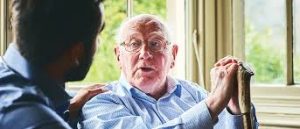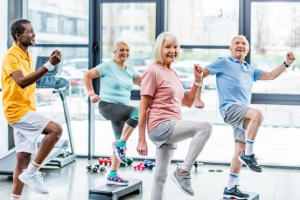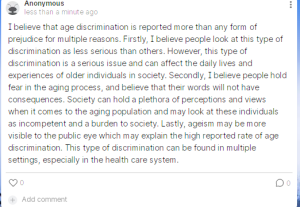6
Section One: The Fundamentals
A) Keywords
Exercise 1:
Provide a brief definition of one of the padlet keywords for this week.
According to Elizabeth Pike, third age refers to the period where someone removes themselves from working and continues their lifestyle in healthy and active ways, enjoying life and their free time. This is evident when people step away from their careers (retirement) and focus on individual enjoyment, health, and activities.
B) The Social Significance of Aging in Sport
Exercise 2: Notebook Prompt
How is old age popularly represented today? Find an image online that you think exemplifies one defining attitude towards old age and paste in your notebook below with a brief explanation of what this image means to you.
I believe that old age is popularly represented both negatively and positively in today’s society. On a positive note, many people show a lot of respect towards older people and look at them as individuals with sources of wisdom, knowledge, and experience. On the other hand, I believe ageism is quite relevant in today’s world. Some people hold negative attitudes, beliefs, and perceptions when it comes to older people and their capabilities. This can be seen when individuals treat older people as if they are incompetent, speak to them in belittling terms, and often fall into ‘elder-speak’ communication. Additionally, I believe that ageist attitudes can be present in some health care professionals and this can impact the type of care older individuals receive, leading to harmful impacts on their lives.
 The picture I chose was to highlight the different treatment older individuals can receive from others. Talking to older individuals in childish and infantilizing terms such as “hey buddy how are you doing today?”, can have negative effects on them such as impairing their cognitive functioning, producing feelings of anger, and lowering self-esteem. Additionally, when it comes to professionals holding ageist attitudes, I have witnessed this first hand with my grandmother when the doctor looked at her symptoms as just repercussions of old age, when in reality (after our family pushed and pushed for tests, answers, specialists) it was an underlying critical disease.
The picture I chose was to highlight the different treatment older individuals can receive from others. Talking to older individuals in childish and infantilizing terms such as “hey buddy how are you doing today?”, can have negative effects on them such as impairing their cognitive functioning, producing feelings of anger, and lowering self-esteem. Additionally, when it comes to professionals holding ageist attitudes, I have witnessed this first hand with my grandmother when the doctor looked at her symptoms as just repercussions of old age, when in reality (after our family pushed and pushed for tests, answers, specialists) it was an underlying critical disease.
Exercise 3: Notebook Prompt
What does the article (referencing another study by Dionigi) mean by its statement that sport can help aging people to simultaneously “accept and resist the ageing process” (572)? Respond by audio or text and find paste two images sourced online into your notebook showing how sport might help aging people to both accept and resist the aging process.
When the article mentions “accept and resist the aging process”, it refers to how older adults who participate in sports can change the associations they have about aging by exerting their capabilities and participating in physical activities like sports. When older individuals participate in sports, it can help them maintain good self-esteem and their physical competence (Elizabeth Pike, 2015). The other benefits that come with older individuals engaging in sports is the physical and mental well-being it provides. Physical activity can help these individuals maintain and promote their health, improve their strength, and protect cardiovascular issues. These settings can also help foster social connections, which is very important to the well-being of older individuals. Overall, participating in sports in old age can significantly help people change their mindset and outlook on life when it comes to the ageing process. Sports can also help older individuals accept the aging process by using physical activity to recognize their bodies and needs and use it as an opportunity for continued growth and enjoyment of life.


Exercise 4: Notebook Prompt
Who are the groups less likely to have extensive opportunities to take part in sports, according to Pike? How does privilege factor into aging and sport? (200 words max)
According to Elizabeth Pike (2015), the individuals who are less likely to have extensive opportunities to take part in sports are individuals with disabilities, the vulnerable, certain marginalized groups, people in care facilities, and rural residents. Privilege plays a huge factor in aging and sport because people come from different socio-economic backgrounds all over the world and differ in their access to resources that promote physical activity throughout their lifetime. As people age, those who had a more upper hand when it came to greater access to sports, playing in sport leagues, acquiring training and coaching, and greater financial support when they were younger, may be more likely to engage in sports and maintain their physical abilities as they get older. In contrast, those who come from a lower socio-economic background or had limited to no access to sports growing up may find it difficult to find opportunities to engage with sport as they age. This highlights the cycle of privilege around the world and shows how certain groups have more of an unequal advantage when it comes to participating in sport.
Exercise 5: Padlet Discussion
Why do you think age discrimination is “reported more than any form of prejudice” with older people presented as a threat to social values and interests? Feel welcome to use video in your responses. Paste your comments (or transcript of your video) below!
I believe that age discrimination is reported more than any form of prejudice for multiple reasons. Firstly, I believe people look at this type of discrimination as less serious than others. However, this type of discrimination is a serious issue and can affect the daily lives and experiences of older individuals in society. Secondly, I believe people hold fear in the aging process, and believe that their words will not have consequences. Society can hold a plethora of perceptions and views when it comes to the aging population and may look at these individuals as incompetent and a burden to society. Lastly, ageism may be more visible to the public eye which may explain the high reported rate of age discrimination. This type of discrimination can be found in multiple settings, especially in the health care system.

B) Older Women and Sport
Exercise 6: Notebook Prompt
What differences do you see in these ads? Which one is more inclusive? How is age represented or not represented in each? Answer these questions in your notebook.
The first ad that I watched seemed to not be very inclusive of the active way of life older adults participate in. This ad was restricted to only younger athletes and did not show much diversity in age groups when participating in sports. However, this ad did an exceptional job showing diversity in the athletes shown, showing people of all races, gender, and abilities. The second ad I watched included more representation of older adults and highlighted how they too can participate in a daily active lifestyle. This ad did a great way showing how older adults (particularly females) participate in sport teams and physical activities despite their busy lifestyle. Overall, I believe the second ad was more inclusive when it comes to the aging population, but both showed good inclusion of the different levels of sport people participate in around the world.
Exercise 7: Notebook Prompt
In her article, “Assessing the sociology of sport: On age and ability,” Elizabeth Pike references a “trend towards a ‘feminisation of ageing’, with many women living longer than men” (573). Do you agree that aging has been “feminized” in this way? How? Answer these questions in your notebook.
I believe that aging has been feminized in a way due to many factors. Firstly, as females tend to live longer than men, this can distort societal views when it comes to the aging process of females. This can put a target on older female adults and put them in a category of being looked at as an issue. Secondly, women may face more problems when it comes to economic resources, particularly when living alone, and may be more subject to social isolation. Lastly, the way that society and women perceive the aging process may differ in the way males do, affecting the way they think about and view themselves.

